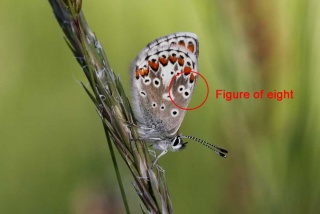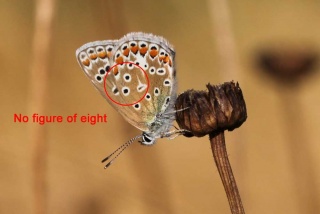by Martin Kalaher
Introduction
Identifying a Brown Argus is often fairly straightforward, especially when we come across a territorial male on a prominent perch of low vegetation. With a patient, slow approach a close examination is usually possible, and then we can see that it is a very small chocolate-brown butterfly with orange margins. The males are feisty little insects and will chase after any butterfly that comes within range only to return to the same perch, or another one, nearby. Wandering through the flower meadow we spot a small brown butterfly deep within the undergrowth and now the ID is anything but straightforward as the females of Brown Argus and the 'mostly-brown', Common Blue females are so similar. It is possible to separate these species in the field but so much better if we have a photograph to scrutinise.
Open Wings
Brown Argus
With uniform chocolate-brown uppersides, a prominent black dot in the middle of the forewings and orange lunules around the margins of all four wings, this is a Brown Argus. Both sexes have six orange lunules on the forewings but only the innermost four usually show well in the males, with the fifth and sixth lunules generally smaller and faded. The blue hairs on the thorax and abdomen of this male Brown Argus show well, reminding us that this species is a member of the blue family.
Common Blue
This female Common Blue is as an extreme example of a mostly-blue female Common Blue and in the field could easily be mistaken for a male Common Blue. All female Common Blues have orange lunules on the margins of the upperside wings, but they generally don't stand out in quite the same way as in Brown Argus. Even mostly-blue female Common Blues have some brown around the margins of the wings.
Brown Argus
Every female Brown Argus has six very large, bold orange lunules on the forewings. Females also have blue hairs on the thorax and abdomen, but compared to the males, they are not usually quite so obvious. Some females have bold dark lines that cross the whole of the white outer fringe, but they are narrow lines compared to the broad markings of the 'chequered fringe' of both Adonis and Chalkhill Blue. In this individual, the dark lines are most noticeable on the left forewing.
Common Blue
The uppersides of this butterfly are mostly brown but there is a generous dusting of blue scales on all four wings, which rules out Brown Argus (as this species never has blue scales on the wings) and identifies it as a female Common Blue. On the forewing of this butterfly there are only three orange lunules that can be easily seen, which again rules out Brown Argus which has 4-6 orange lunules.
Brown Argus
For most male Brown Argus it is only the innermost four orange lunules on the forewings that show well but this does vary and in this individual all six are prominent. Sexing a butterfly can be helpful when we are trying to separate a male Brown Argus from a mostly-brown female Common Blue. The shape of the abdomen of a male Brown Argus is long and narrow and gradually tapers to a broad tip, which is square-ended, or slightly curved. Whereas females have shorter, fatter abdomens with a pointed tip. This butterfly is clearly a male.
Common Blue
This butterfly is dark brown, it has four bold, orange lunules on the forewing and the thorax is covered in blue hairs. These three features might suggest a male Brown Argus. However, there is no central black dot in the centre of the forewing and critically there is a light dusting of blue scales on the left forewing, and so it cannot be a Brown Argus and must be a female Common Blue. If we look at the rear margin of the hindwing, each orange lunule sits on a central black spot, which in turn sits on a base of bluish-white, all of which reminds me of a multi-coloured beehive. This extensive bluish-white at the base of the 'beehive' is a good ID feature for female Common Blues.
Brown Argus
This butterfly has uniform chocolate-brown uppersides, a prominent black dot in the middle of the forewings and bold orange lunules around the margins of all four wings. It has four well-demarcated orange lunules on the forewing, the fifth lunule is smaller and faded and the sixth is absent. This is a male Brown Argus.
Common Blue
Examining the right forewing, the background colour is brown, there is a dark dot in the middle of the forewing, and there are four orange lunules. These features might suggest a male Brown Argus, however, there is a dusting of blue scales and so it cannot be a Brown Argus. For me, what also says female Common Blue are the bright multi-coloured 'beehives' on the margin of the hindwing.
Brown Argus
Uniform chocolate-brown uppersides, a prominent black dot in the middle of the forewings and orange lunules around the margins of all four wings says this is a Brown Argus. Just four orange lunules on the forewing and a male-shaped abdomen tells us this is a male Brown Argus.
Common Blue
Not a high-quality photograph but the right forewing and right hindwing show well enough. The extensive dusting of blue scales on the inner wings means this butterfly cannot be a Brown Argus and therefore must be a female Common Blue. The multi-coloured 'beehives' of the rear edge of the hindwing also strongly points towards female Common Blue.
Closed Wings
Brown Argus
With closed wings, these two blue butterflies have more similarities than differences. Both have a brown background; both have a lovely row of orange marks on the rear edges of both wings; and both have a scattering of black spots. However, this butterfly has a figure-of-eight situated midway on the leading edge of the hindwing and there are no black spots on the inner half of the forewing. These two ID points tell us this is a Brown Argus. There are prominent dark lines crossing the whole of the brownish-white fringe and so this is a female.
Brown Argus
There is a figure-of-eight on the leading edge of the hindwing and there are no black spots on the inner half of the forewing. It has dark lines crossing the off-white outer fringe of both wings. It is a female Brown Argus.
Brown Argus
There is a figure-of-eight on the leading edge of the hindwing and there are no black spots on the inner half of the forewing. Once we see the figure-of-eight on the hindwing we can be very confident we are looking at a Brown Argus.
Common Blue
There is a black spot on the inner half of the forewing but there is no figure-of-eight on the hindwing and therefore it is a female Common Blue. This photograph featured in the 2019 Christmas Quiz. As the hindwings are slightly separated, we can see a slither of brown on the upperside hindwing, which means it must be a female.
Brown Argus
There is a figure-of eight, mid-way on the leading edge of the hindwing but there are no spots on the inner half of the forewing. There are narrow dark lines crossing the whole of the outer fringe of both wings. This is a female Brown Argus.
Common Blue
There is a spot on the inner half of the forewing but there is no figure-of-eight on the leading edge of the hindwing and so this butterfly is a Common Blue. The hairs on the thorax are a light grey (no obvious blue hairs) and the outer fringe of the forewing is more brown than white (in the male it is usually a brilliant white) so I think we can we safely say this is a female.
Brown Argus
With its wings tightly closed we have a very limited view of the forewing. However, mid-way on the leading edge of the hindwing there is a figure-of-eight and so this is a Brown Argus. The body hairs are grey (with no obvious blue hairs) and there are narrow, dark lines crossing the whole of the outer fringe and so this is a female.
Common Blue
We cannot see any spots on the inner half of the forewing, but the hindwing is obscuring most of this inner half, therefore a black spot may be present but hidden from view. The key to this photograph is the absence of a figure-of-eight on the leading edge of the hindwing, which means it must a Common Blue.



-1156704514.jpg)
-3660160675.jpg)
-7310529248.jpg)
-9231706736.jpg)
-9415075457-3385274554.jpg)
-1481817993-4125808100.jpg)
-2047689440.jpg)
-5895992466.jpg)
-2930036135.jpg)
-170749644.jpg)
-9981118333-1211804011.jpg)
-7476167995-2533179004.jpg)
-1681421254.jpg)
-6437300960.jpg)
-3788050920.jpg)
-5836361995.jpg)
-6654100390-2012406634.jpg)
-2603825684-7308363444.jpg)

-8994131740.jpg)

-7434308906.jpg)